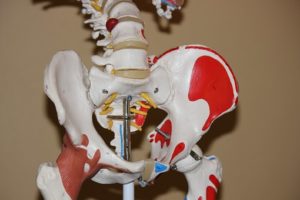 The hip is important in transmitting forces from the leg through to the spine. A proper functioning hip is essential in tasks such as walking, standing up from sitting and getting into and out of your car. However, when problems occur within the hip joint it becomes increasingly difficult to perform these tasks. This can cause hip pain and lead to back and even knee problems!
The hip is important in transmitting forces from the leg through to the spine. A proper functioning hip is essential in tasks such as walking, standing up from sitting and getting into and out of your car. However, when problems occur within the hip joint it becomes increasingly difficult to perform these tasks. This can cause hip pain and lead to back and even knee problems!
Osteoarthritis (OA) of the hip is the most common cause of hip joint pain. It often comes on gradually and can go for years without noticing. However, it can become difficult to distinguish this type of pain early on, as the back and surrounding musculature are often also affected. This can often disguise the true driver of the hip pain. It’s important to keep in mind that it’s not just the elderly who are affected by hip arthritis.
Here are some characteristic features of early OA:
- Pain in the groin which can refer to the back or outside hip
- Pain that is worse with activity and relieved by rest
- Unable to tolerate sitting in low chairs
- Slight limping while walking
- Noticeable stiffness when getting out of bed in the morning that resolves within 30 minutes
Types of Osteoarthritis
There are two types of osteoarthritis; primary and secondary. Primary osteoarthritis occurs when the developing arthritis cannot be attributed to a clear cause. Whereas secondary osteoarthritis occurs when the hip arthritis was a result of clear anatomical abnormalities of the hip, such as congenital hip problems.
What is the physiology behind hip osteoarthritis?
The process usually starts with a minor degradation, or ‘wearing out’ of the cartilage within the hip. In response to this stress, thickening of the bone occurs and subsequent small growths around the hip joint (osteophytes) can form. Ongoing inflammation of the hip joint can occur which causes gradual narrowing of the joint space (as shown on an XRAY) – below.
What are the risk factors of hip arthritis:
- Women aged >50
- Previous hip or major lower limb injuries sustained
- Obesity
- History of heavy physical stress at work or manual labour
- Family history of osteoarthritis
How can Physiotherapy help?
Physiotherapy can help to identify any early symptoms of osteoarthritis and reduce further progression of the condition. This will often involve exercises to strengthen the deeper muscles around the hip and back, targeted stretches and manual therapy to relieve pressure through the hip joint. An XRAY may also be ordered to confirm the degree of arthritis. If investigations have revealed significant arthritis within the hip joint, it is recommended to receive an orthopaedic evaluation in conjunction with Physiotherapy.
Get your hip assessed by the staff at Bend + Mend Physiotherapy today!





